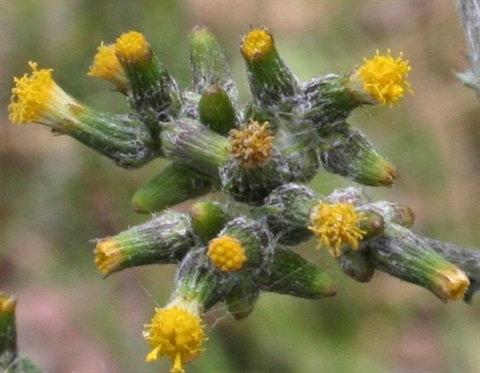
Senecio glomeratus ssp. glomeratus
Annual Fireweed
Erect annual or short-lived perennial herb, new growth greyish with cobwebbed hairs.
Additional information
- FamilyAsteraceae
- StoreyLower storey
- Size0.5-2 m high
- Plant groupingHerbs & Groundcovers <1m
- LeavesStalkless lance-shaped to egg-shaped leaves, 3-15 cm x 10-50 mm, becoming narrower up the stem, toothed lobes at base, jagged teeth or lobed margins, densely white cobwebbed below.
- Flower colourYellow
- Flowering timeSeptember to February
- FlowersDense terminal bunches of small rayless daisy flowerheads. Bracts purple. Whitish cobwebbed hairs at base of flowerheads. Seeds, to 1.7 mm long, are mid to dark red-brown with a tuft of hairs more than 5 mm long on top.
- Bird attractingNo
- Butterfly attractingFood plant for caterpillars
- Frog habitatNo
- Growing conditionsMoist soil in forests and woodlands, sometimes near water, colonising disturbed or bare ground, or amongst rocks. Full sun, semi-shade.
- Garden useGrow in bush areas. Adds a natural element to the area. Interesting leaves.
- Commercially availableWholesale only - order in advance
- Conservation statusLocally common within its preferred growing conditions. Possibly occurs in Buxton Gum Swampy Riparian Woodland.
- Related speciesSenecio glomeratus ssp. longifructus differs in that upper leaves almost hairless below, flower stalks sparsely cobwebby, bracts purple-tipped. Seed is slightly longer with the tuft of hairs < 5 mm long. Outer seeds are greenish. Occurs next to swamps. S. hispidulus is similar and occurs in similar habitats, differing in leaf texture - leaves bristly hairy on top, lightly curly-hairy below, basal lobes with 2 coarse teeth. Bracts of flowerhead green, hairless.
Photo Gallery
Photographer/s: Marilyn Bull ©
Plant Communities